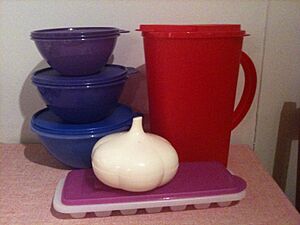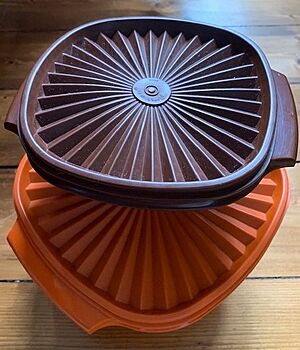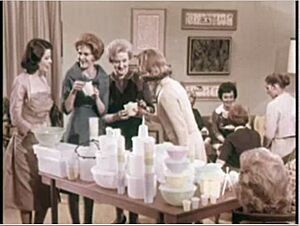Tupperware facts for kids
| Subsidiary | |
| Founded | 1946 Leominster, Massachusetts |
| Founder | Earl Tupper |
| Headquarters | Orlando, Florida, U.S. |
| Products | Preparation, storage, serving products for the kitchen and home, and beauty products |
| Revenue | |
|
Number of employees
|
13,500 (2010) |
| Parent | Party Products LLC |
Tupperware is an American company that makes and sells containers for kitchens and homes all over the world. It was started in 1942 by Earl Tupper. He created his first special container and showed his products to everyone in 1946.
For many years, Tupperware was sold by millions of people who worked directly for the company. In 2013, Indonesia was the biggest market for Tupperware, selling over $200 million worth of products.
In September 2024, Tupperware's parent company faced financial difficulties. Two months later, a new company called Party Products LLC bought the Tupperware brand. This allowed Tupperware to continue making and selling its famous products.
Contents
The Story of Tupperware
How Tupperware Started
Earl Tupper bought plastic pellets to create Tupperware products in 1938. He made the first product in 1946 in Leominster, Massachusetts. These plastic containers were designed to keep food fresh and airtight. They had a special "burping seal" that Earl Tupper patented in 1949.
Tupperware became very popular because of a unique way of selling them. This was called the "Tupperware party." These parties were held in people's homes. Brownie Wise, who was good at sales, started organizing many of these parties. She became a vice president in 1951 and later created Tupperware Parties Inc.
During the early 1950s, Tupperware products grew in popularity. Sales increased a lot. The company kept holding Tupperware parties and rewarded the women who sold the most products.
Tupperware Around the World
Tupperware started selling in Europe in 1960. Mila Pond held the first Tupperware parties in Weybridge, England. The company also expanded to other parts of the world. Salespeople would visit homes and show how Tupperware containers kept food fresh. This often led to more Tupperware parties being scheduled.
Tupperware also made a few products that were not just for food storage. One example is the Shape O, a toy puzzle for toddlers. It was first made in 1969. This toy has ten different shapes that fit into matching holes in a ball.
Tupperware Today
In 2003, Tupperware stopped selling products in the UK and Ireland. They felt customers were not happy with their direct sales method. The company tried to restart in the UK in 2011 but later canceled the plan.
By 2007, about 1.9 million people were selling Tupperware directly. In May 2018, Tupperware left Israel but later returned as an online shop in 2020. The company also closed operations in the Netherlands in 2021 and in New Zealand in 2022.
In November 2022, Tupperware announced that it was having financial difficulties. The company's stock value dropped a lot. In April 2023, Tupperware warned that it might not be able to continue operating without a lot of new investment.
As of April 2023, Tupperware sold products in 82 countries. In June 2023, Tupperware stopped using independent salespeople in the UK and Ireland. They started selling products online and through a shopping TV channel.
In October 2023, Laurie Ann Goldman became the new CEO of Tupperware. In June 2024, Tupperware announced it would close its last factory in the US. Production moved to their plant in Mexico.
In September 2024, Tupperware Brands Corp. announced it was facing serious financial problems. This led to the company filing for bankruptcy. However, in November 2024, the Tupperware brand was bought by Party Products LLC. This allowed Tupperware's operations to continue.
Tupperware Parties
Tupperware is still mostly sold through the "party plan." A Tupperware party is led by a Tupperware consultant. This person invites friends and neighbors to their home to see the products. Parties can also happen in workplaces or other community groups.
To keep in touch with its salespeople, Tupperware published a magazine called Tupperware Sparks. This magazine showed pictures of saleswomen receiving awards for high sales. Tupperware also created special events to get free publicity instead of spending money on advertising.
In recent years, Tupperware in North America has changed its business model. They now focus more on selling directly to customers. They also tried selling through stores like Target in the US. In countries like Germany and Australia, where parties are still the main focus, Tupperware's sales have gone down. In New Zealand, you can now buy products online without a salesperson.
In China, Tupperware products are sold through special "entrepreneurial shopfronts." There were 1,900 of these stores in 2005. This is because of laws about how products can be sold.
Tupperware and Women
People have different ideas about how Tupperware affected women. Some thought Tupperware gave jobs to women who might not have been able to work otherwise. This was helpful because laws about work were not always fair to women.
Others believed that Tupperware's products and selling style kept women focused only on housework. They argued that it encouraged women to stay mostly in the home.
Tupperware History Records
There are several collections of Tupperware history. These records, papers, and collections are kept in museums and archives across the United States.
The papers of founder Earl Tupper are at the Smithsonian Institution's National Museum of American History. The records of Brownie Wise, a key vice president, are also at the same museum. The Jon and Sylvia Boyd Tupperware Films collection at the Smithsonian Institution shows documentaries about the yearly meetings for salespeople. These meetings were held at Tupperware's headquarters in Florida.
See also
 In Spanish: Tupperware para niños
In Spanish: Tupperware para niños
- Generic trademark
- Gold party
- Hana Cobi Plastic
- Newell Rubbermaid
- Tub (container)





